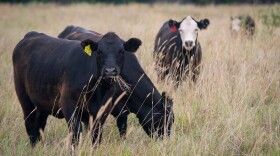Last fall the Mississippi River fell to low water levels when a flash drought exacerbated a dry spell in the upper part of the river’s basin. Soon it was more expensive for a grain company to send corn from St. Louis to New Orleans than it was to ship to China.
“It was a disaster,” said Butler Miller, president of barge company Robert B. Miller & Associates in St. Louis. “Last year was a once-in-a-30-year event.”
It was the worst Miller had seen, but flash droughts are becoming more common as climate change accelerates, according to research from a team of university scientists, including the University of Oklahoma, the University of Wisconsin–Madison and others.
In the most extreme emissions model from the new study, North America could have a 49% annual risk of experiencing a flash drought in 2100, up from 32% in 2015. Across the globe and across emission scenarios, the likelihood of flash droughts increase.
The abrupt dryness — like what’s beginning to spread across states like Iowa, Missouri and Illinois, according to preliminary modeling — can cause crops and vegetation to wither even more quickly than they do in long-term droughts.
“Instead of something that takes place over six months or 12 months, these are events that happen over three to six weeks,” said Jeffrey Basara, a professor at the University of Oklahoma who worked on the research. “And because they have rapid developments, they can catch people by surprise.”

Studies on flash drought are relatively new, and he said modeling has a long way to go before it can give advance notice. Basara said he hopes one day flash drought can have its own category of weather forecasts, similar to a thunderstorm watch or tornado warning.
“The science has to get better in predictability,” he said. “By the time people realize they’re in a drought, it’s too late. We want to increase the awareness aspect of it.”
Like all droughts, flash droughts develop when there’s not enough precipitation. Hot, sunny weather quickly zaps moisture from soil and reinforces dry conditions.
The 2012 drought began as a flash drought and went on to destroy at least $30 billion of goods. A 2010 flash drought in Russia developed into a heat wave, sparking wildfires and killing thousands of people.
Rebecca Vittetoe is monitoring the start of a flash drought in her work as a field agronomist with Iowa State University extension. After a week with little rain and 90 degree days, she’s noticed stunted plants and struggling root systems.
It’s early enough in the season that Vittetoe isn’t too anxious – but she said dry conditions could be devastating if they don’t improve for crucial growing phases like a corn’s pollinating period or a soybean’s pod filling stage.

“Right now, the dryness is making roots go down in the soil to find moisture,” she said. “But at some point we’re going to need rain because we’re depleting that subsoil moisture. If we don’t start getting rain, I’m going to get more concerned, because it will start having more of an impact.”
As for the shipping industry, Miller said if parched conditions become a mainstay on the Mississippi River, he believes it may move toward rail transportation.
“If you can’t move goods or it’s really expensive, I would think railing out west would be quite attractive,” he said. “You’d have to say ‘I need a more reliable insurance policy to make sure the goods get to their end user.’”
This story was produced in partnership with Harvest Public Media, a collaboration of public media newsrooms in the Midwest. It reports on food systems, agriculture and rural issues.
Copyright 2023 KCUR 89.3. To see more, visit KCUR 89.3. 9(MDA4OTAxNzAzMDEzMjc0MTc2MzA5ZDZlMw004))







